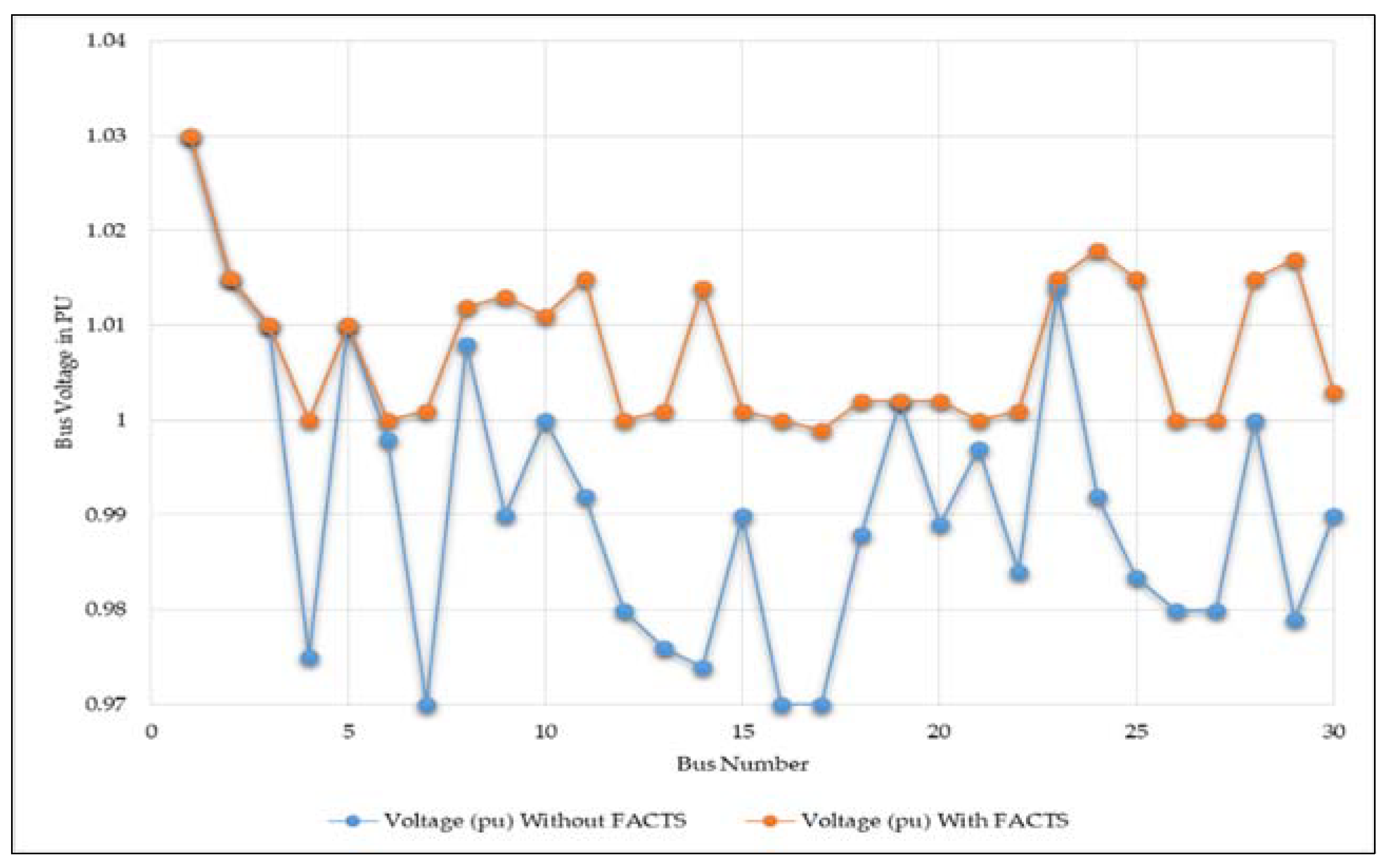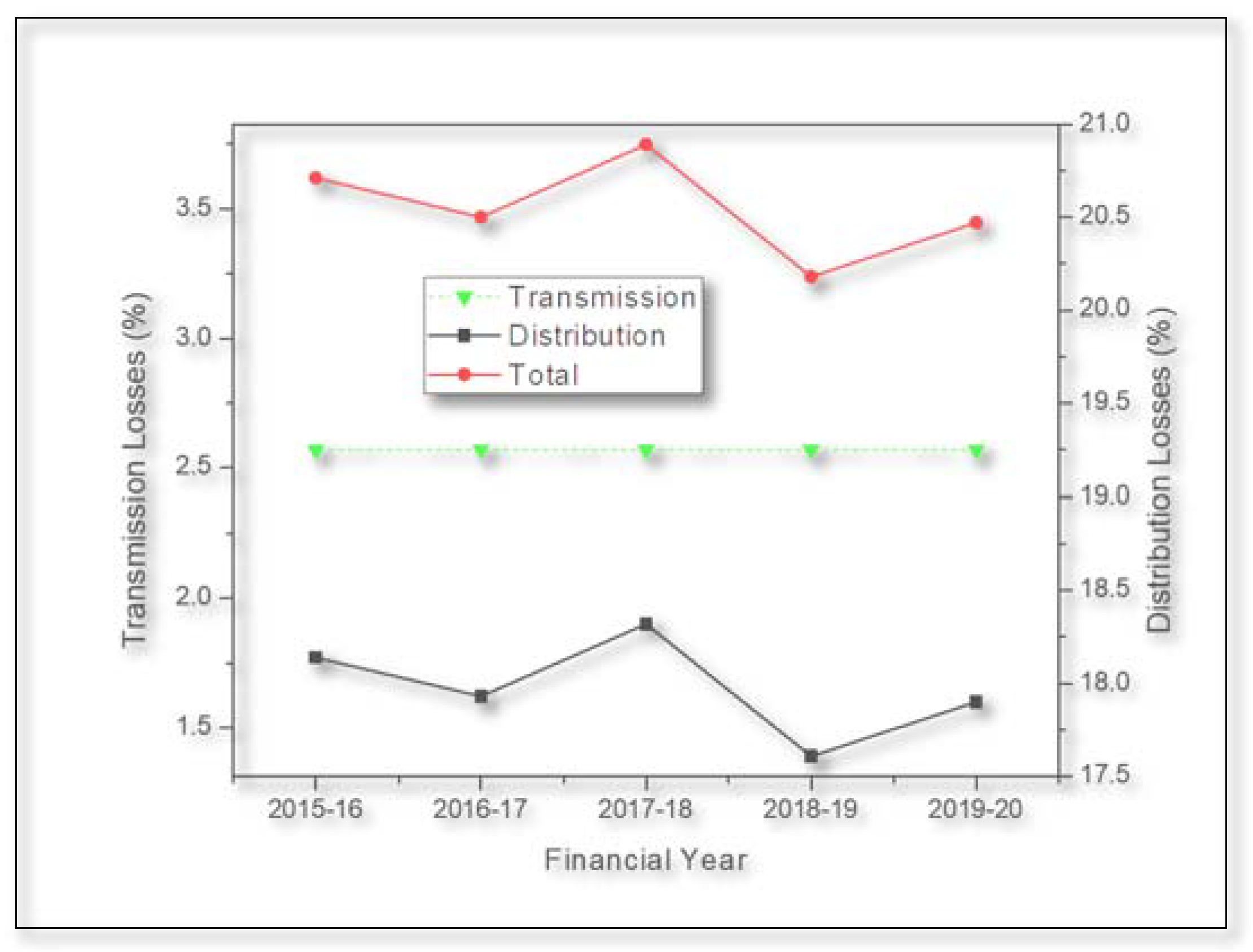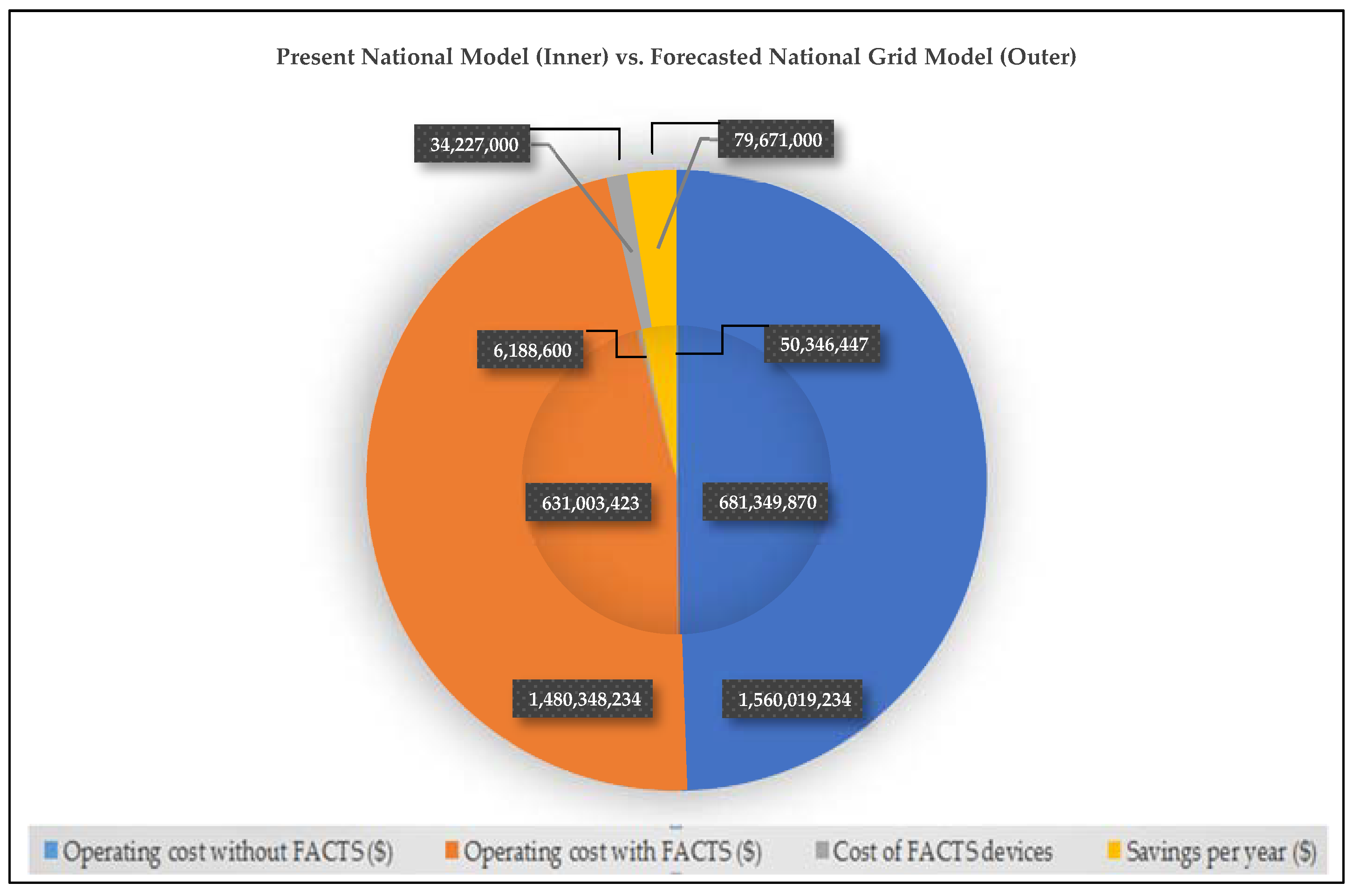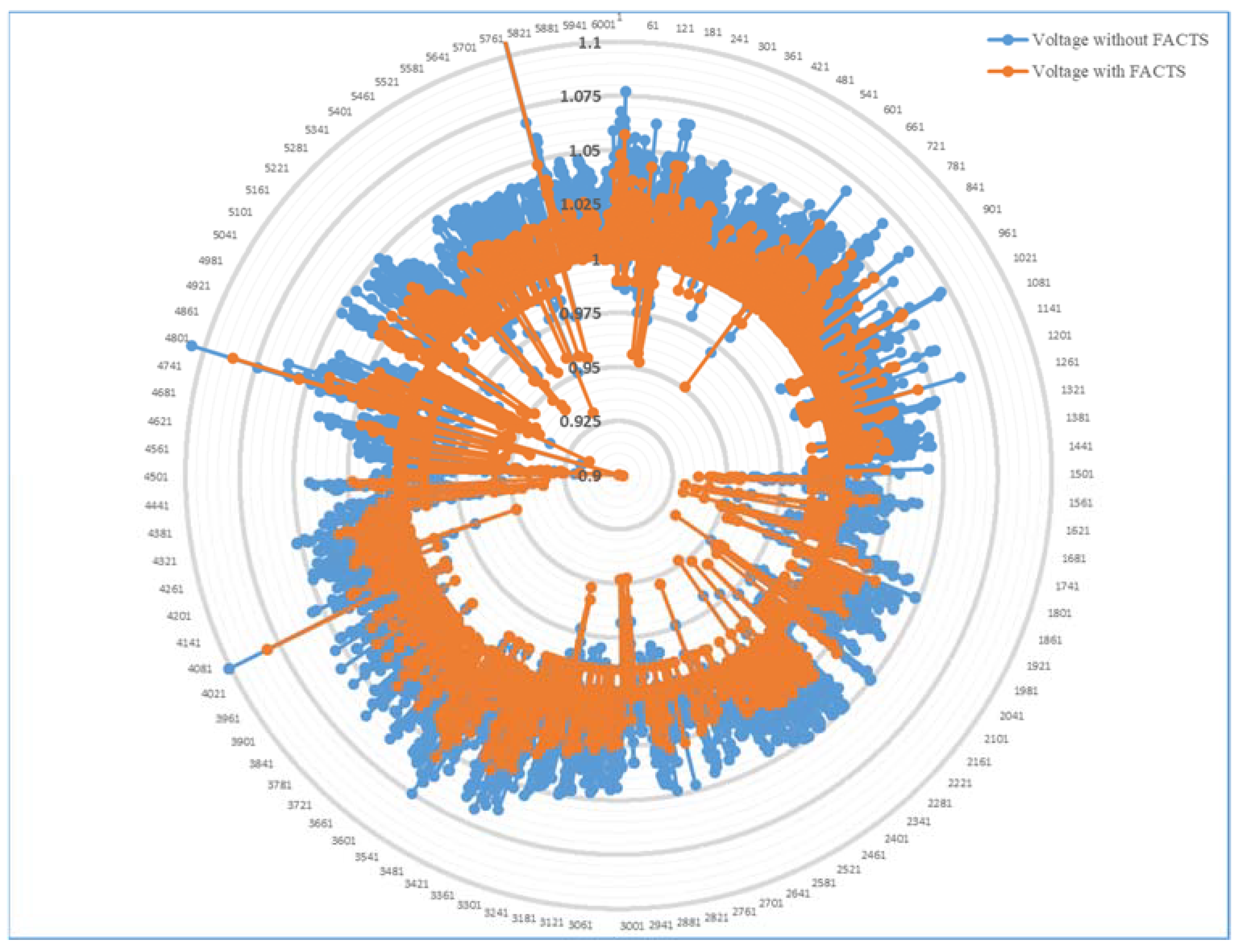Ensuring Reliable Operation of Electricity Grid by Placement of FACTS Devices for Developing Countries
Abstract
1. Introduction
2. Methodology
2.1. Modelling of TCSC
2.2. Modelling of SVC
2.3. Optimal Allocation of FACTS
2.3.1. Optimal Allocation of TCSC
2.3.2. Optimal Allocation of SVC
2.4. Optimal Sizing of FACTS
2.4.1. Mathematical Formulation
2.4.2. Particle Swarm Optimization
2.4.3. Flow Chart for Placement and Sizing of FACTS
3. Results and Discussion
3.1. Test Case IEEE-14 and 30 Bus Systems
3.2. Practical National Grid of Developing Country
3.2.1. Finding Weak Lines Using Index
3.2.2. Finding Weak Buses Using VCPI Index
3.2.3. Optimal Rating of FACTS and Its Effect on National Grid Losses
4. Conclusions
Author Contributions
Funding
Institutional Review Board Statement
Informed Consent Statement
Data Availability Statement
Acknowledgments
Conflicts of Interest
Disclaimer
References
- Almeshqab, F.; Ustun, T.S. Lessons learned from rural electrification initiatives in developing countries: Insights for technical, social, financial and public policy aspects. Renew. Sustain. Energy Rev. 2019, 102, 35–53. [Google Scholar] [CrossRef]
- IRENA. Renewable Capacity Statistics 2019; International Renewable Energy Agency (IRENA): Abu Dhabi, United Arab Emirates, 2019. [Google Scholar]
- Meyabadi, A.F.; Deihimi, M.H. A review of Demand Side Management: Reconsidering theoretical framework. Renew. Sustain. Energy Rev. 2017, 80, 367–379. [Google Scholar] [CrossRef]
- Jabir, H.J.; Teh, J.; Ishak, D.; Abunima, H. Impacts of Demand Side management on Electrical Power Systems: A review. Energies 2018, 11, 1050. [Google Scholar] [CrossRef]
- Bhatti, S.S.; Umair, E.M.; Lodhi, U.; Haq, S. Electric Power Transmission and Distribution Losses Overview and Minimization in Pakistan. Int. J. Sci. Eng. Res. 2015, 6, 1108–1112. [Google Scholar]
- Wood Allen, J.; Bruce, F.; Wollenberg, G.B.S. Power Generation, Operation and Control, 3rd ed.; Wiley-IEEE Press: Piscataway, NJ, USA, 2014; ISBN 9781626239777. [Google Scholar]
- Tauhidi, A.; Chohan, U.W. The Conundrum of Circular Debt; Centre for Aerospace and Security Studies (CASS): Islamabad, Pakistan, 2020. [Google Scholar] [CrossRef]
- Ali, M.; Ahmed, A.B. Multiple-Criteria Policy Anaysis of Circular Debt in Pakistan. In Proceedings of the 2020 International Conference on Engineering and Emerging Technologies (ICEET), Lahore, Pakistan, 22–23 February 2020; pp. 1–7. [Google Scholar]
- Valasai, G.D.; Uqaili, M.A.; Memon, H.U.R.; Samoo, S.R.; Mirjat, N.H.; Harijan, K. Overcoming electricity crisis in Pakistan: A review of sustainable electricity options. Renew. Sustain. Energy Rev. 2017, 72, 734–745. [Google Scholar] [CrossRef]
- National Electric Power Regulatory Authority. State of Industry Report 2020; National Electric Power Regulatory Authority: Islamabad, Pakistan, 2020; Volume 1. [Google Scholar]
- Rafique, M.M.; Rehman, S. National energy scenario of Pakistan—Current status, future alternatives, and institutional infrastructure: An overview. Renew. Sustain. Energy Rev. 2017, 69, 156–167. [Google Scholar] [CrossRef]
- Nawaz, S.; Nasir, I.; Anwar, S. Electricity Demand in Pakistan: A Nonlinear Estimation. Pak. Dev. Rev. 2013, 52, 479–491. [Google Scholar] [CrossRef]
- Shahid, M.; Ullah, K.; Imran, K.; Mahmood, I.; Mahmood, A. Electricity supply pathways based on renewable resources: A sustainable energy future for Pakistan. J. Clean. Prod. 2020, 263, 121511. [Google Scholar] [CrossRef]
- Mubeen, S.E.; Khan, B.; Nema, R.K. Application of Unified Power Flow Controller to Improve Steady State Voltage Limit. IAES Int. J. Robot. Autom. 2017, 6, 277. [Google Scholar] [CrossRef]
- Kavitha, K.; Neela, R. Optimal allocation of multi-type FACTS devices and its effect in enhancing system security using BBO, WIPSO & PSO. J. Electr. Syst. Inf. Technol. 2018, 5, 777–793. [Google Scholar]
- Raj, S.; Bhattacharyya, B. Optimal placement of TCSC and SVC for reactive power planning using Whale optimization algorithm. Swarm Evol. Comput. 2018, 40, 131–143. [Google Scholar] [CrossRef]
- Gaur, D.; Mathew, L. Optimal placement of FACTS devices using optimization techniques: A review. In Proceedings of the 3rd International Conference on Communication Systems (ICCS-2017), Rajasthan, India, 14–16 October 2017; Volume 331. [Google Scholar]
- Kolcun, M.; Čonka, Z.; Beňa, L.; Kanálik, M.; Medveď, D. Improvement of Transmission Capacity by FACTS devices in Central East Europe power system. IFAC-PapersOnline 2016, 49, 376–381. [Google Scholar] [CrossRef]
- Gandoman, F.H.; Ahmadi, A.; Sharaf, A.M.; Siano, P.; Pou, J.; Hredzak, B.; Agelidis, V.G. Review of FACTS technologies and applications for power quality in smart grids with renewable energy systems. Renew. Sustain. Energy Rev. 2018, 82, 502–514. [Google Scholar] [CrossRef]
- Bhole, S.S.; Nigam, P. Improvement of Voltage Stability in Power System by Using SVC and STATCOM. Int. J. Adv. Res. Electr. Electron. Instrum. Eng. 2015, 4, 749–755. [Google Scholar]
- AL Ahmad, A.; Sirjani, R. Optimal placement and sizing of multi-type FACTS devices in power systems using metaheuristic optimisation techniques: An updated review. Ain Shams Eng. J. 2019. [Google Scholar] [CrossRef]
- Bhattacharyya, B.; Kumar, S. Loadability enhancement with FACTS devices using gravitational search algorithm. Int. J. Electr. Power Energy Syst. 2016, 78, 470–479. [Google Scholar] [CrossRef]
- Jmii, H.; Meddeb, A.; Chebbi, S. A combination between FACTS devices for a safe and an economic power system operation. In Proceedings of the 4th International Conference on Control Engineering & Information Technology (CEIT), Hammamet, Tunisia, 16–18 December 2017; pp. 1–6. [Google Scholar] [CrossRef]
- Hermanu, C.; Listiyanto, O.; Ramelan, A. Comparison of Static Var Compensator (SVC) and Unified Power Flow Controller (UPFC) for Static Voltage Stability Based on Sensitivity Analysis: A Case Study of 500 KV Java-Bali Electrical Power System. In Proceedings of the 2019 International Conference on Technologies and Policies in Electric Power & Energy, Yogyakarta, Indonesia, 21–22 October 2019; pp. 1–6. [Google Scholar] [CrossRef]
- Chikkadesai, M.; Allu, D.; Kamalapur, G.D. Comparative Analysis of TCSC and STATCOM in Power System. In Proceedings of the 2018 International Conference on Electrical, Electronics, Communication, Computer and Optimization Techniques (ICEECCOT), Msyuru, India, 14–15 December 2018; pp. 185–190. [Google Scholar] [CrossRef]
- Relic, F.; Maric, P.; Glavas, H.; Petrovic, I. Influence of FACTS device implementation on performance of distribution network with integrated renewable energy sources. Energies 2020, 13, 5516. [Google Scholar] [CrossRef]
- Ramanathan, B.; Elizondo, D.; Enslin, J.; Zhang, L. Cost effective FACTS solution for transmission enhancement and its economic assessment. In Proceedings of the 2006 IEEE/PES Transmission & Distribution Conference and Exposition, Caracas, Venezuela, 15–18 August 2006; pp. 1–6. [Google Scholar] [CrossRef]
- Ghahremani, E.; Kamwa, I. Optimal placement of multiple-type FACTS devices to maximize power system loadability using a generic graphical user interface. IEEE Trans. Power Syst. 2013, 28, 764–778. [Google Scholar] [CrossRef]
- Bansal, H.O.; Agrawal, H.P.; Tiwana, S.; Singal, A.R.; Shrivastava, L. Optimal Location of FACT Devices to Control Reactive Power. Int. J. Eng. Sci. Technol. 2010, 2, 1556–1560. [Google Scholar]
- Panigrahi, B.K.; Suganthan, P.N.; Das, S. Optimal Placement and Sizing of Multi-type Facts Devices Using PSO and HSA. In Proceedings of the International Conference on Swarm, Evolutionary, and Memetic Computing, Bhubaneswar, India, 18–20 December 2014. [Google Scholar]
- Sharma, A.; Chanana, S.; Parida, S. Combined optimal location of FACTS controllers and loadability enhancement in competitive electricity markets using MILP. In Proceedings of the IEEE Power Engineering Society General Meeting, San Francisco, CA, USA, 12–16 June 2005. [Google Scholar]
- Saravanan, M.; Slochanal, S.M.R.; Venkatesh, P.; Prince, S.A.J. Application of PSO technique for optimal location of FACTS devices considering system loadability and cost of installation. In Proceedings of the 2005 International Power Engineering Conference IPEC2005, Singapore, 29 November–2 December 2005. [Google Scholar]
- Jirjees, M.A.; Al-Nimma, D.A.; Al-Hafidh, M.S.M. Voltage Stability Enhancement based on Voltage Stability Indices Using FACTS Controllers. In Proceedings of the International Iraqi Conference on Engineering Technology and Its Applications, IICETA, Al-Najaf, Iraq, 8–9 May 2018. [Google Scholar]
- Nadeem, M.; Imran, K.; Khattak, A.; Ulasyar, A.; Pal, A. Optimal Placement, Sizing and Coordination of FACTS Devices in Transmission Network Using Whale Optimization Algorithm. Energies 2020, 13, 753. [Google Scholar] [CrossRef]
- Araga, I.A.; Anibasa, A.O.; Alabi, I.I. Open Access Placement of Multiple Svc on Nigerian Grid System for Steady State Operational Enhancement. Am. J. Eng. Res. 2017, 6, 78–85. [Google Scholar]
- Alsheikh, M.; Osman, A. Contingency Analysis in Presence of SVC Controller of Sudan National Grid for Electricity. Ph.D. Thesis, University of Science and Technology, Omdurman, Sudan, 2018. [Google Scholar]
- Al-rubayi, R.H.; Ibrahim, L.G. Optimal Placement of FACTs Devices in Iraqi National Super Grid System (INSGS) Using HLSI. Int. J. Eng. Technol. Sci. 2019, 6, 100–114. [Google Scholar]
- Zimmerman, R.D.; Murillo-Sánchez, C.E.; Thomas, R.J. MATPOWER: Steady-state operations, planning, and analysis tools for power systems research and education. IEEE Trans. Power Syst. 2011, 26, 12–19. [Google Scholar] [CrossRef]
- Nuchhi, S. Comparative Study of TCSC and SVC for Power System. Int. J. Recent Adv. Eng. Res. 2017, 3, 1. [Google Scholar] [CrossRef]
- Nadeem, M.; Zeb, M.Z.; Imran, K.; Janjua, A.K. Optimal Sizing and Allocation of SVC and TCSC in Transmission Network by combined Sensitivity index and PSO. In Proceedings of the 2019 International Conference on Applied and Engineering Mathematics (ICAEM), London, UK, 3–5 July 2019; pp. 111–116. [Google Scholar]
- Anwar, Z.; Malik, T.N.; Sarfraz, A.; Hameed, H.; Rehman, A.; Abbas, T. Applications of FACTS/ESS in Power System Congestion Management with Large Renewable Energy Sources Using PSS/E and Experienced in National Grid of Pakistan. J. Appl. Emerg. Sci. 2018, 8, 77–95. [Google Scholar]
- Padiyar, K.R. Facts Controllers in Power Transmission Distribution; New Age Internatopnal (P) Limited: New Delhi, India, 2007; ISBN 9788122425413. [Google Scholar]
- National Electric Power Regulatory Authority Consumer-End Applicable Tariff. Available online: https://nepra.org.pk/consumeraffairs/ElectricityBill.php (accessed on 15 January 2021).
- James Kennedy, R.E. Particle Swarm Optimization. In Proceedings of the ICNN’95-International Conference on Neural Networks, Perth, WA, Australia, 27 November–1 December 1995. [Google Scholar]
- Bhattacharyya, B.; Kumar, S. Approach for the solution of transmission congestion with multi-type FACTS devices. IET Gener. Transm. Distrib. 2016, 10, 2802–2809. [Google Scholar] [CrossRef]
- National Electric Power Regulatory Authority. State of Industry Report; National Electric Power Regulatory Authority: Islamabad, Pakistan, 2018. [Google Scholar]










| S. No | IEEE-14 Bus System | IEEE-30 Bus System | |
|---|---|---|---|
| 1 | Power Generating Units | 5 | 6 |
| 2 | Transmission Lines | 20 | 41 |
| 3 | Load Busses | 9 | 20 |
| Line | Branch | at Maximum Loading Point | Rank |
|---|---|---|---|
| 4–7 | 8 | 0.998 | 1st |
| 4–9 | 9 | 0.993 | 2nd |
| 7–9 | 15 | 0.97 | 3rd |
| 10–11 | 18 | 0.89 | 4th |
| 13–14 | 20 | 0.8 | 5th |
| 4–5 | 7 | 0.78 | 6th |
| 9–14 | 17 | 0.67 | 7th |
| 12–13 | 19 | 0.629 | 8th |
| 9–10 | 16 | 0.587 | 9th |
| Load Bus No. | VCPI at Maximum Loading Point | Rank |
|---|---|---|
| 14 | 1.0023 | 1st |
| 4 | 1.0007 | 2nd |
| 9 | 0.9704 | 3rd |
| 5 | 0.9363 | 4th |
| 11 | 0.906 | 5th |
| 12 | 0.8904 | 6th |
| 7 | 0.8687 | 7th |
| 13 | 0.8355 | 8th |
| 10 | 0.8173 | 9th |
| Type of FACTS | Location | Optimal Rating (p.u) | Power Loss without FACTS (p.u) | Power Loss with FACTS (p.u) | Power Loss Reduction (p.u) |
|---|---|---|---|---|---|
| TCSC | 4–7 | 0.081 | |||
| TCSC | 4–9 | 0.079 | |||
| TCSC | 7–9 | 0.08 | |||
| TCSC | 10–11 | 0.077 | 0.1436 | 0.092 | 0.052 |
| SVC | 14 | 0.0453 | |||
| SVC | 4 | 0.468 | |||
| SVC | 9 | 0.249 | |||
| SVC | 5 | 0.0891 |
| FACTS Type | Location Bus/Branch | Optimal Rating (p.u) | Total True Power Loss without FACTS (p.u) | Total True Power Loss with FACTS (p.u) | Total Reduction in True Power Loss (p.u) |
|---|---|---|---|---|---|
| TCSC | 7 | 0.051 | |||
| TCSC | 15 | 0.039 | |||
| TCSC | 20 | 0.01 | |||
| TCSC | 28 | 0.067 | 0.1755 | 0.130 | 0.0425 |
| SVC | 30 | 0.017 | |||
| SVC | 29 | 0.5 | |||
| SVC | 26 | 0.38 | |||
| SVC | 25 | 0.11 |
| Sr. No | Bus Voltage (kV) | Number of Buses | |
|---|---|---|---|
| Present Model | Forecasted Model | ||
| 1 | 500 | 26 | 53 |
| 2 | 220 | 86 | 192 |
| 3 | 132 | 1222 | 1994 |
| 4 | 66 | 153 | 233 |
| 5 | 33 | 16 | 114 |
| 6 | 11 | 2148 | 3094 |
| Sr. No | Description | National Grid | |
|---|---|---|---|
| Present Model | Forecasted Model | ||
| 1 | Total Number of Buses | 3651 | 6007 |
| 2 | Power Generating Units | 277 | 797 |
| 3 | Transmission Lines | 4147 | 10,110 |
| 4 | Load Busses | 1930 | 2961 |
| 5 | Total Generation Capacity | 73,343.7 MW | 20,405.90 MW |
| 6 | Generation (actual) | 22,337.3 MW | 42,434.4 MW |
| 7 | Load | 21,483.6 MW | 40,584.5 MW |
| Grid Model | From Bus (kV)–To Bus (kV) | Value | Rank |
|---|---|---|---|
| 2018 | Dadu (220)–Khuzdar (220) | 0.859 | 1st |
| D G Khan (500)–Guddu (500) | 0.835 | 2nd | |
| Sarfaraz Nagar-I (220)–Okara-I (220) | 0.832 | 3rd | |
| Sarfaraz Nagar-II (220)–Okara-II (220) | 0.832 | 4th | |
| M. Garh (500)–Guddu (500) | 0.805 | 5th | |
| Lalazar-I (220)–Maripur-I (220) | 0.799 | 6th | |
| Lalazar-II (220)–Maripur-II (220) | 0.799 | 7th | |
| 2025 | Shahi Bagh (220)–Jamrud (220) | 0.923 | 1st |
| Tarbela (500)–Gatti (500) | 0.882 | 2nd | |
| Dadu Khel (220)–Bannu (220) | 0.874 | 3rd | |
| Sialkot (220)–Ghakkar-II (220) | 0.847 | 4th | |
| Okara (220)–Yousafwall (220) | 0.831 | 5th | |
| Sumundri (220)–Multan (220) | 0.811 | 6th | |
| Nagshah (220)–M. Garh (220) | 0.792 | 7th |
| Grid Model | Bus Name | Base Voltage (kV) | VCPI Value | Rank |
|---|---|---|---|---|
| Current Model | Ludewala | 220 | 0.963 | 1st |
| Port Qasim | 500 | 0.905 | 2nd | |
| Guddu | 500 | 0.889 | 3rd | |
| Sarfaraz Nagar | 220 | 0.807 | 4th | |
| Bandalan | 220 | 0.758 | 5th | |
| Multan | 220 | 0.738 | 6th | |
| Forecasted Model | Quetta | 220 | 0.999 | 1st |
| Bannu | 220 | 0.973 | 2nd | |
| Moro | 500 | 0.963 | 3rd | |
| Muzaffar Garh | 500 | 0.935 | 4th | |
| Okara | 220 | 0.919 | 5th | |
| Gujrat | 220 | 0.878 | 6th |
| FACTS Type | Location Bus (SVC)/Line (TCSC) | Optimal Rating of FACTS (p.u) | Location Bus (SVC)/Line (TCSC) | Optimal Rating of FACTS (p.u) |
|---|---|---|---|---|
| Present Model | Forecasted Model | |||
| TCSC | Dadu–Khuzdar | 0.0035 | Shahu Bagh–Jamrud | 0.001 |
| TCSC | D G Khan–Guddu | 0.0098 | Tarbela–Ghatti | 0.035 |
| TCSC | Sarfaraz Nagar-I–Okara-I | 0.0119 | Dadu Khel–Bannu | 0.210 |
| TCSC | Sarfaraz Nagar-II–Okara-II | 0.0133 | Sialkot–Ghakkar-II | 0.119 |
| TCSC | M. Garh–Guddu | −0.0095 | Okara–Yousafwala | 0.991 |
| TCSC | Lalazar-I–Maripur-I | −0.0074 | Sumundri–Multan | 0.871 |
| TCSC | Lalazar-II–Maripur-II | 0.0122 | Nagshah–M.Garh | 0.012 |
| TCSC | Bundrd-I–Lahore | 0.0029 | Shahu Bagh–Jamrud | 0.009 |
| SVC | Ludewala | −0.7721 | Quetta | 0.653 |
| SVC | Port Qasim | 0.6979 | Bannu | −0.872 |
| SVC | Guddu | −0.7837 | Moro | −0.403 |
| SVC | Sarfaraz Nagar | −0.1149 | Muzaffar Garh | 0.971 |
| SVC | Bandalan | 0.5879 | Okara | 0.449 |
| SVC | Multan | −0.1898 | Gujrat | 0.008 |
| S. No | Description | Present Model | Forecasted Model |
|---|---|---|---|
| 1 | Number of Busses | 3651 | 6007 |
| 2 | Number of Lines | 4147 | 10,110 |
| 3 | System Losses (MW) | 853.67 | 1967.18 |
| 4 | Mod of SVC Rating | 3.1463 | 3.56 |
| 5 | Mod of TCSC Rating | 0.0705 | 2.248 |
| 6 | Total Cost of TCSCs ($) | 7.1371 × 103 | 2.6847 × 107 |
| 7 | Total Cost of SVCs ($) | 6.1815 × 106 | 7.3795 × 106 |
| 8 | Total cost of FACTS devices ($) | 6.1886 × 106 | 3.4227 × 107 |
| 9 | Payback Period | Less than 1 Year | Less than 1 Year |
Publisher’s Note: MDPI stays neutral with regard to jurisdictional claims in published maps and institutional affiliations. |
© 2021 by the authors. Licensee MDPI, Basel, Switzerland. This article is an open access article distributed under the terms and conditions of the Creative Commons Attribution (CC BY) license (http://creativecommons.org/licenses/by/4.0/).
Share and Cite
Khan, A.N.; Imran, K.; Nadeem, M.; Pal, A.; Khattak, A.; Ullah, K.; Younas, M.W.; Younis, M.S. Ensuring Reliable Operation of Electricity Grid by Placement of FACTS Devices for Developing Countries. Energies 2021, 14, 2283. https://doi.org/10.3390/en14082283
Khan AN, Imran K, Nadeem M, Pal A, Khattak A, Ullah K, Younas MW, Younis MS. Ensuring Reliable Operation of Electricity Grid by Placement of FACTS Devices for Developing Countries. Energies. 2021; 14(8):2283. https://doi.org/10.3390/en14082283
Chicago/Turabian StyleKhan, Atif Naveed, Kashif Imran, Muhammad Nadeem, Anamitra Pal, Abraiz Khattak, Kafait Ullah, Muhammad Waseem Younas, and Muhammad Shahzad Younis. 2021. "Ensuring Reliable Operation of Electricity Grid by Placement of FACTS Devices for Developing Countries" Energies 14, no. 8: 2283. https://doi.org/10.3390/en14082283
APA StyleKhan, A. N., Imran, K., Nadeem, M., Pal, A., Khattak, A., Ullah, K., Younas, M. W., & Younis, M. S. (2021). Ensuring Reliable Operation of Electricity Grid by Placement of FACTS Devices for Developing Countries. Energies, 14(8), 2283. https://doi.org/10.3390/en14082283






